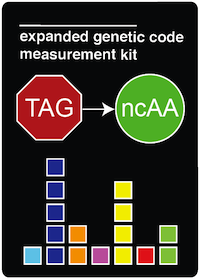Team:Austin Texas
From 2014.igem.org
(Difference between revisions)
| Line 73: | Line 73: | ||
<!-- WIKI CONTENT BEGINS --> | <!-- WIKI CONTENT BEGINS --> | ||
__NOTOC__ | __NOTOC__ | ||
| - | {| | + | {| cellpadding="10" |
|- valign="top" | |- valign="top" | ||
| [[Image:Austin_Texas_Measurement_Kit_Card.png]] | | [[Image:Austin_Texas_Measurement_Kit_Card.png]] | ||
| Line 87: | Line 87: | ||
This summer our team has been working on recreating a lightactivatable T7 RNA Polymerase (RNAP) for a method of noninvasive, spaciotemporal control of protein expression. T7 RNAP was our enzyme of choice for this project due to the presence of a tyrosine residue in the active site of the polymerase. By recoding this tyrosine residue, orthonitrobenzyl tyrosine was incorporated into the active site thus acting as a molecular cage. T7 RNAP is only functional when exposed to a certain wavelength of light that cleaves a molecular cage from the polymerase’s active site. In our experiments, orthonitrobenzyl tyrosine (ONBY) was used as our photocaged ncAA. ONBY was used because once the ONB group is cleaved off, the ncAA functions as a normal tyrosine. This proved to be particularly useful because T7 polymerase has a tyrosine residue in its active site that is necessary for proper function of the protein. Once decaged, the polymerase is free to transcribe sequences that are preceded by a T7 promoter. GFP was used as a reporter to analyze and optimize each construct for spaciotemporal specificity. In addition, GFP was used to examine the effect of a certain noncanonical amino acid on fluorescence when placed in the fluorophore. | This summer our team has been working on recreating a lightactivatable T7 RNA Polymerase (RNAP) for a method of noninvasive, spaciotemporal control of protein expression. T7 RNAP was our enzyme of choice for this project due to the presence of a tyrosine residue in the active site of the polymerase. By recoding this tyrosine residue, orthonitrobenzyl tyrosine was incorporated into the active site thus acting as a molecular cage. T7 RNAP is only functional when exposed to a certain wavelength of light that cleaves a molecular cage from the polymerase’s active site. In our experiments, orthonitrobenzyl tyrosine (ONBY) was used as our photocaged ncAA. ONBY was used because once the ONB group is cleaved off, the ncAA functions as a normal tyrosine. This proved to be particularly useful because T7 polymerase has a tyrosine residue in its active site that is necessary for proper function of the protein. Once decaged, the polymerase is free to transcribe sequences that are preceded by a T7 promoter. GFP was used as a reporter to analyze and optimize each construct for spaciotemporal specificity. In addition, GFP was used to examine the effect of a certain noncanonical amino acid on fluorescence when placed in the fluorophore. | ||
| - | |- | + | |- valign="top" |
| - | + | ||
| - | + | ||
| - | + | ||
| | | | ||
|<h1>Human Practices: Caffeinated Coli @ SXSW Create</h1> | |<h1>Human Practices: Caffeinated Coli @ SXSW Create</h1> | ||
Revision as of 21:01, 16 October 2014
| |||||||||||||||||||||||||||
 "
"


